"Would you tell me, please, which way I ought to go from here?"
"That depends a good deal on where you want to get to."
"I don't much care where-"
"Then it doesn't matter which way you go."
- Lewis Carroll, Alice in Wonderland
Never in a million years did I think I would end up in Bosnia-Herzegovina, yet I have to say this trip was one of the best ideas I have ever had. I joined a Balkan Road Trip, so there were 19 of us, a guide, and a driver that went on a 7 day tour through Mostar, Sarajevo, and everywhere in between.
It was a huge surprise to see Emma, Hannah, and Jenny (the girls I met at my hostel in Split) at the waterfalls. They were taking a day trip from Mostar to the waterfalls. This photo is of me trying to convince Jenny to jump in with me. The water was freezing, like colder than lake Michigan cold.
If you look closely at my face, you can actually see the shock of how cold it was.
The first day we stopped at a place for lunch Mustafa, our guide, suggested getting Cevapi a traditional Bosnian sausage. When he said that it would be 10 sausages, I definitely thought there would at least be a sprig of parsley or something, nope it was exactly 10 sausages on a plate.
Our first two days were spent in Mostar. The town was once a major trading town in the Ottoman Empire.
This is probably the most well-known site in Bosnia, the stari most or old bridge. The bridge actually gives the city it's name. Most is bridge and the Mostar are the keepers of the bridge.
This whole town was a disaster waiting to happen for me. Well worn slippery stones were everywhere.
One of the local alcohols is Rakija, or brandy made from different types of fruit. We were served a little bit before our dinner. This type was made from cherry.
This was the building across the street from our hostel. A lot of the city was destroyed in the '92-'25 war. Since then most of the old town has been repaired, however if you look up a lot of the second stories have yet to be repaired.
On our walking tour we visited a mosque and climbed to the top of the minaret. I just really really hate stairs.
Sorry I have about a million photos of this bridge.
There were these two guys who would jump off the bridge if the tourists payed them 25 euros.
The next day we walked through parts of the new town. Here the war was definitely apparent. It is crazy to think that anyone over the age of 15 lived through a war. The girl who gave us the walking tour talked about hearing the bombs go off and of how she was still terrified of fireworks. It is crazy to be in a place that had a war in my lifetime. For me as an American war seems so far away, this trip definitely brought it closer.
After the walking tour I walked with Ben and Lauren, an Australian couple, to see the WWII Partisan Memorial. The memorial was built in 1965 to honor the men who died in WWII. It is sad that most of the cemeteries, parks, and memorials have fallen into disrepair, but I guess when your country had a war less than 20 years ago and you currently have a 46% unemployment rate you have more important things to worry about than keeping up WWII memorials.
This place was very strange, since it was built by the communists they designed it so that there was not any symbols or lines of any kind that could be connected to religion.
If you look really close to the top of the mountain on the right side you can see a little bit of snow on the top.
Again it was super weird seeing bombed out buildings and even if the buildings were not bombed out they were covered in shrapnel and bullet holes.
The old bridge was destroyed in the war. Our tour guide said that when the bridge was destroyed her mother wept, not for the bridge but because of what it meant. If they were willing to destroy one of the nations symbols what weren't they willing to do?
If you look closely at the second picture you can see right about the roofs of the colored houses you can see the guy who jumped off the bridge.
This used to be a park, however during the war no one could leave the city because of the snipers in the hills so they had to bury the dead in the park. It is very strange to walk through a cemetery and not have any of the people buried there over the age of 50.
This was our last night in Mostar and half the group. From left to right: Mike (Scotland), Alex (Australia), Andy (Scotland), Will (Wales), Ben (Australia), and our guide Mustafa. In Mostar, we were in a five person dorm and Andy was one of the people in the room. We quickly learned that he talked in his sleep. At about 4:00 AM he sat up in bed and said, "ok good night everybody" and then laid back down. Our room also only had two quilts even though there was 5 people. During the night Andy must have gotten cold so he grabbed what was nearby which was Robyn's towel. Robyn woke up the next morning to take a shower only to find that Andy was covered with her towel. Needless to say he was extremely embarrassed the next morning.
Basically I took one photo of this bridge every hour for the two days I was there. I am pretty sure I could make a time-lapse video with all the photos I took.
After two days in Mostar we got up bright and early and went to Konjic to do some white water rafting. The company actually took photos for us and then gave everyone a disk with them on. I am really glad I have it because I didn't really take any photos of the other members of the group, so at least I have these.
On this table up the left side and down the right side: Alex (Australia), Will (Wales), Ben (Australia), Robyn (Australia), Lauren (Australia), Melissa (Australia), Lizzie (Australia), Sophie (Australia), Moran (Australia), and Alyssa (US).
These two are Rod and Cathy another couple from Australia.
This women is Cindi. Her and her husband Graham are from London. They were they sweetest cutest couple ever.
I don't care how fit anyone is, no one looks good in a wet suit.
I love this photo because you can just see how uncomfortable everyone is.
The rafting was not exactly strenuous but the scenery was beautiful.
This guy was our skipper, and actually reminded me a lot of my boss at the Town Hall, Mike.
This poor guy was being trained to be a skipper and was definitely being put through the ringer. The other skippers shoved him out of the boat three times into the freezing river.
Giant rapid coming, can't you see me getting ready? Actually I have no idea what I was looking at here.
After rafting we had the most amazing meal. There were two types of soup, really good salads, these doughnut type breads, and baked chicken and potatoes.
Then we drove on to Sarajevo.
It's funny to look into the small villages and see the minarets from the mosques instead of steeples from the churches like I would see at home.
The first night we went to this old communist movie theater that has now been turned into a bar.
The bar was really cool. There was a band that walked around among the tables singing traditional songs. It was really cool to see all the people singing along. One thing I will say however is that I had forgotten what it was like to be in a place where people smoke inside. By the end of the night my eyes were aching and the next morning my throat hurt.
This was the mural on the stairs leading up to our hostel. We had very strange hostel owners. The man at this hostel actually yelled at Sophie telling her that it was not the time for jokes, because he was busy.
Also at this hostel we were assigned to rooms, where at the other hostels we just chose our rooms. This was fine except that at first the owner thought I was a boy and put me in the boys room. After we informed him that "Erin" is a girl's name I was moved to the girls room. Since there was five of us we got our own studio apartment which was super nice. However we had to walk out on this creepy roof in order to get to our apartment.
This building is the national library. The library was built as a town hall in 1891. In order to build houses needed to be demolished. Everyone sold their houses to the government except for one man who refused to sell. He refused and refused until a higher official came. The official went to talk to him and finally agreed to his demands.
This man's stubbornness payed off. He not only got them to move his house across the river he also got the money. This is that house and is now called the stubborn man.
Since Bosnia was at one point part of the Ottoman Empire Bosnia has also adopted the craft of copper working and coffee. After the war the hills were littered with thousands of empty shell casings. The copper smiths found that the shells were basically the same metal that they use. So they now make pens, key-chains, and other engraved and carved items out of the empty shells. This just shows how adaptable the people of Sarajevo are. However I bought some of these and apparently empty shells are somehow still dangerous according to the security guy at the airport. But thankfully they let me through. Now we will just see how US security feels about it.
Since Sarajevo is predominantly Muslim, the call to prayer happens five times a day. The city has a man who studies when the sun rises and sets just so that he can adjust this clock so that the people pray at exactly the right time.
This city has always been very accepting of differences. What other city can you find a mosque and then a block later a cathedral, and a block later a synagogue? Mustafa also pointed out that the city is extremely proud of keeping this acceptance after the war. The people could have easily turned against one group and blamed them but they didn't.
This is known as a Sarajevo Rose. These are sights where mortar shells killed one or more people. After the war the scars left in the concrete where the shells landed were filled in with red resin as a memorial to the people.
This market was the site of two massacres during the war. The first happened in 1994, 68 people were killed and 144 were wounded. The second happened in 1995 and killed 43 people with 75 wounded. The first massacre was actually caught on tape by a camera crew who was filming a story at the market place. At first the Serbian government claimed that the Bosnian government had actually fired the shell to gain support from the international community. It is no wonder that this market now has a roof over it.
So for those of you who do not remember/were not paying attention when the war was happening this was how it was explained, of course I was in Bosnia so this is the Bosnian side. In 1992 Bosnia declared independence from Yugoslavia, Slovenia and Croatia had declared independence earlier. Serbia kind of agreed but said that Serbia should get any land that had a majority of Serbians in it and there were pockets of Serbians throughout the region. Another huge problem was that since Yugoslavia was one country it only had one army and once the country broke up, Serbia had control of that entire army. So at the first part of the war the only people with weapons fighting for Bosnia were the police and the gangsters. So The Christian Serbs fought to control land from the Muslim Bosnia's. In some places if there was not a majority of Serbians in the area the Serbians made a majority by massacring the Bosnian's. I know this is a super simplified version of what happened but there really is no way to understand everything that went into this war. Mustafa our guide was 15 when the war began. He told stories of dodging snipers and running into buildings when the shelling started to hide out. He also said that he can tell you exactly the caliber of a bullet or shell by the sound that it makes flying. He can also tell by the whistle how far away the bomb was and if he was being in danger of being hit. This is definitely a skill that I never ever want to learn. He also told us that he was a really good whistler and freaked the teacher out by making whistling sounds while in class. Even in times of war teenagers are horrible.
This city also happens to be the place where Archduke Franz Ferdinand was assassinated starting WWI. As Mustafa said, they sure know how to start wars if only they learned how to end them.
This was my second attempt at cevapi, and this time was delicious. It was served in delicious bread with lettuce, tomato, and corn.
This man was one of the copper smiths. He was really nice and showed us how they create the coffee grinders.
Sarajevo should be known as the city of cemeteries. Everywhere you looked from the lookout point you could see the white tombstones.
The building with the smoke coming out of it was one of the most important buildings in Sarajevo during the war. The building is the brewery and is sitting on top of a natural spring. During the war the brewery was the only place for the residents to get water.
Our last night in Sarajevo we ate at a restaurant with really cool menus. And while we ate our meal a stray dog came and sat on my feet. Everyone else thought it was adorable I just thought about the fleas it probably had.
On our final day in Sarajevo we went to the tunnel museum. During the war an 800 meter long tunnel was built underneath the UN controlled airport. The city was surrounded on three sides by Serbian forces and on the fourth side by the airport which the Serbians only left because the UN wanted it to get aid in. Mustafa had gone through the tunnel when he was 16. He couldn't believe that on the other side there were actually shops that were open.
The tunnel was 800 meters long and under 2 meters tall.
The next day we drove 3 hours to Srebrenica which is the site of the greatest genocide in Europe since WWII. In 1993 the UN declared the area a safe zone and the city was protected by a battalion of Dutch troops. However these Dutch troops did not do anything to stop the Serbian troops from coming in and taking over. As the Serbian army came closer and closer to the city the people fled to the Dutch fort. The Dutch finally let in a few thousand people but then shut the gates. The Serbian Army came and separated the men from the women. The men were then put on trucks and taken to another town where they were killed. Some of the men tried to escape by running through the mountains. Few actually made it back into Bosnian controlled territory. The rest were rounded up by the Serbian Army and killed. In total over 8,000 men and boys were slaughtered.
From the video you can see the Dutch soldiers handing over the Bosnians to the Serbs. The Serbians were partying! It is sickening.
This is a former battery factory and where the Dutch command was.
This was our guide Hassan. He had survived the massacre. He ran 6 days and 6 nights across the mountains to get to the Bosnian territory. The anger in this man's eyes when he talked about the massacre was quite scary, but definitely warranted.
This was the safest place during the war in Sarajevo. This is where the foreign journalists stayed and the Serbians wanted to make sure that the international community did not intervene.
For the final two days of the trip we went into the mountains where the 1984 Winter Olympics were held. We got to stay in a ski lodge with actual hotel rooms. It was a great way to end the trip.
We attempted a hike in the woods, but it was really really wet and slippery.
Unfortunately the fog was really low so we were not able to see the top of the mountain.
This was a daily occurrence, Catherine (Ireland) is an accountant and so she figured out how much everyone owed every night since no one in Europe seems to be able to split a bill.
On the way out of the mountains we stopped at Igman Mountain which is where the ski jump was held during the Olympics.
On our way back to Croatia we stopped at Bosnia's largest cave.
I promise I am wearing pants in this photo the jacket was just super huge.
The caves had this type of fish called the human fish in them. This freaky fish has legs.










































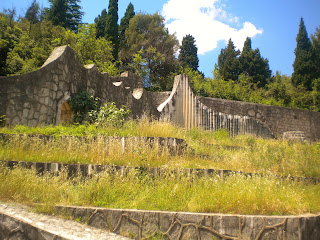





























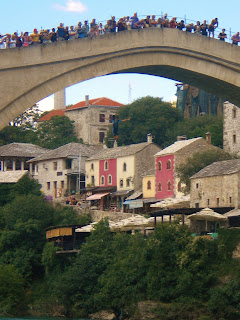





















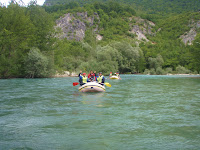


































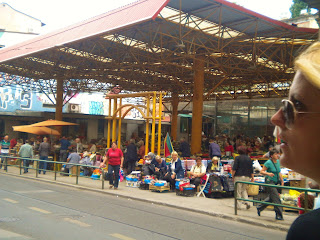











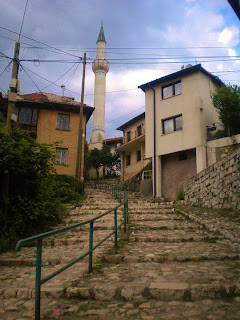























































No comments:
Post a Comment